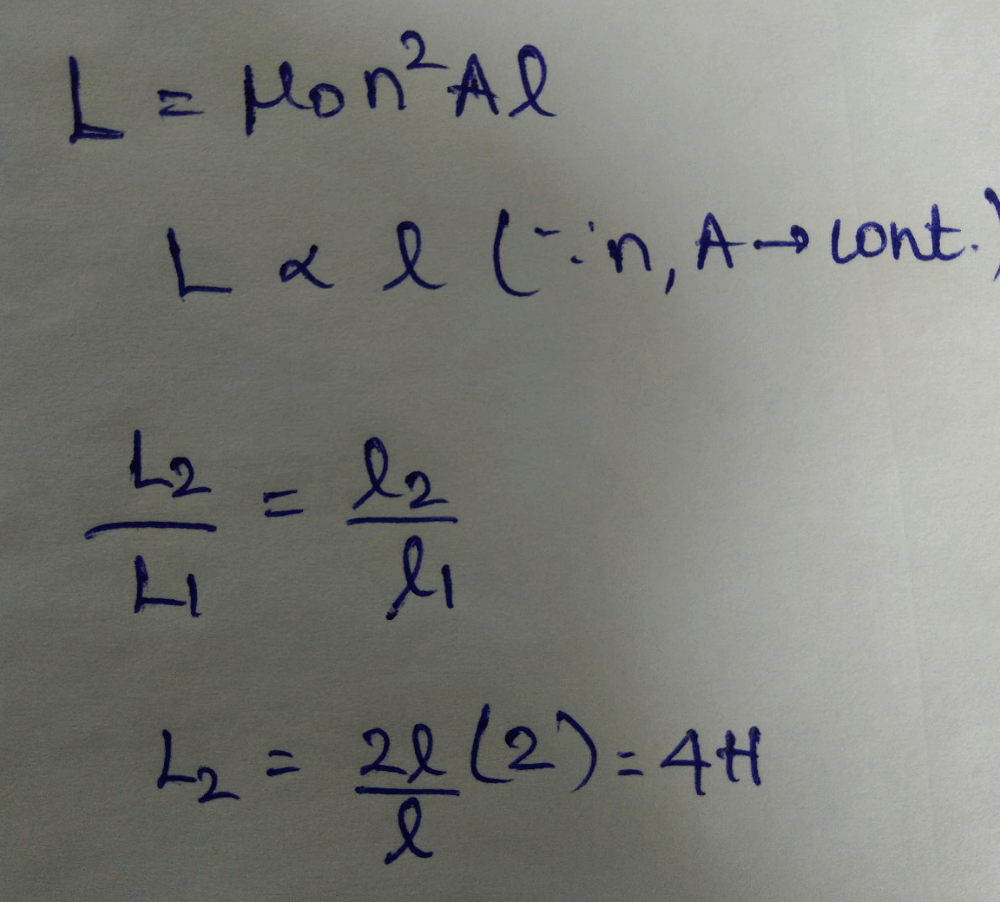NEET Exam > NEET Questions > ?a solenoid have self inductance 2H if length...
Start Learning for Free
a solenoid have self inductance 2H if length of solenoid is double having turn density and area constant then new self inductance?
Most Upvoted Answer
?a solenoid have self inductance 2H if length of solenoid is double ha...
Effect of Length on Self-Inductance of a Solenoid
Introduction
A solenoid is a coil of wire that generates a magnetic field when an electric current is passed through it. The self-inductance of a solenoid is a measure of its ability to store energy in the magnetic field produced by it. It depends on various factors such as the number of turns, the cross-sectional area, and the length of the solenoid.
Effect of Length on Self-Inductance
The self-inductance of a solenoid is directly proportional to the square of the number of turns and the cross-sectional area, and inversely proportional to the length of the solenoid. Thus, if the length of the solenoid is doubled while keeping the turn density and area constant, the self-inductance of the solenoid will decrease by a factor of 4.
Explanation
The self-inductance of a solenoid can be calculated using the formula L = μ0n^2A/l, where L is the self-inductance, μ0 is the permeability of free space, n is the number of turns per unit length, A is the cross-sectional area, and l is the length of the solenoid.
If the length of the solenoid is doubled while keeping the turn density and area constant, the new length will be 2l, and the new self-inductance can be calculated using the same formula as L' = μ0n^2A/(2l).
Substituting the value of L in terms of L' in the above equation, we get L' = L/4. Thus, the new self-inductance of the solenoid will be 1/4th of the original self-inductance.
Conclusion
In conclusion, the self-inductance of a solenoid is inversely proportional to its length, and doubling the length of the solenoid while keeping the turn density and area constant will result in a decrease in the self-inductance by a factor of 4. This effect can be explained using the formula for self-inductance of a solenoid.
Community Answer
?a solenoid have self inductance 2H if length of solenoid is double ha...

Attention NEET Students!
To make sure you are not studying endlessly, EduRev has designed NEET study material, with Structured Courses, Videos, & Test Series. Plus get personalized analysis, doubt solving and improvement plans to achieve a great score in NEET.

|
Explore Courses for NEET exam
|

|
Similar NEET Doubts
?a solenoid have self inductance 2H if length of solenoid is double having turn density and area constant then new self inductance?
Question Description
?a solenoid have self inductance 2H if length of solenoid is double having turn density and area constant then new self inductance? for NEET 2024 is part of NEET preparation. The Question and answers have been prepared according to the NEET exam syllabus. Information about ?a solenoid have self inductance 2H if length of solenoid is double having turn density and area constant then new self inductance? covers all topics & solutions for NEET 2024 Exam. Find important definitions, questions, meanings, examples, exercises and tests below for ?a solenoid have self inductance 2H if length of solenoid is double having turn density and area constant then new self inductance?.
?a solenoid have self inductance 2H if length of solenoid is double having turn density and area constant then new self inductance? for NEET 2024 is part of NEET preparation. The Question and answers have been prepared according to the NEET exam syllabus. Information about ?a solenoid have self inductance 2H if length of solenoid is double having turn density and area constant then new self inductance? covers all topics & solutions for NEET 2024 Exam. Find important definitions, questions, meanings, examples, exercises and tests below for ?a solenoid have self inductance 2H if length of solenoid is double having turn density and area constant then new self inductance?.
Solutions for ?a solenoid have self inductance 2H if length of solenoid is double having turn density and area constant then new self inductance? in English & in Hindi are available as part of our courses for NEET.
Download more important topics, notes, lectures and mock test series for NEET Exam by signing up for free.
Here you can find the meaning of ?a solenoid have self inductance 2H if length of solenoid is double having turn density and area constant then new self inductance? defined & explained in the simplest way possible. Besides giving the explanation of
?a solenoid have self inductance 2H if length of solenoid is double having turn density and area constant then new self inductance?, a detailed solution for ?a solenoid have self inductance 2H if length of solenoid is double having turn density and area constant then new self inductance? has been provided alongside types of ?a solenoid have self inductance 2H if length of solenoid is double having turn density and area constant then new self inductance? theory, EduRev gives you an
ample number of questions to practice ?a solenoid have self inductance 2H if length of solenoid is double having turn density and area constant then new self inductance? tests, examples and also practice NEET tests.

|
Explore Courses for NEET exam
|

|
Suggested Free Tests
Signup for Free!
Signup to see your scores go up within 7 days! Learn & Practice with 1000+ FREE Notes, Videos & Tests.

























